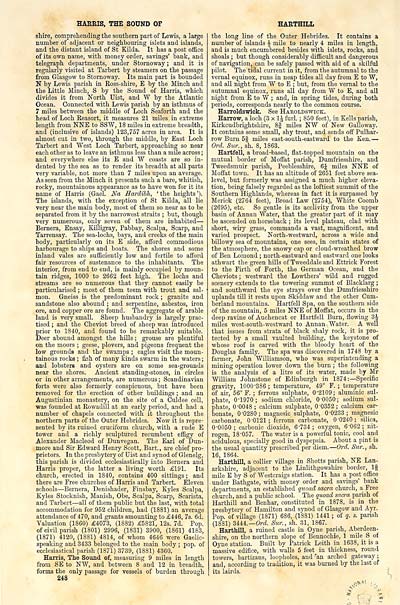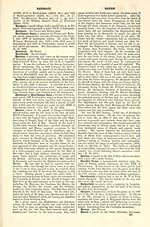Ordnance gazetteer of Scotland > Volume 3
(318) Page 248
Download files
Complete book:
Individual page:
Thumbnail gallery: Grid view | List view

HARRIS, THE SOUND OF
shire, comprehending the southern part of Lewis, a large
numher of adjacent or neighbouring islets and islands,
and the distant island of St Kilda. It has a post office
of its own name, with money order, savings' bank, and
telegraph departments, under Stornoway ; and it is
regularly visited at Tarbert by steamers on the passage
from Glasgow to Stornoway. Its main part is bounded
N by Lewis parish in Eoss-shire, E by the Minoh and
the Little Minch, S by the Sound of Harris, which
divides it from North Uist, and W by the Atlantic
Ocean. Connected with Lewis parish by an isthmus of
7 miles between the middle of Loch Seaforth and the
head of Loch Reasort, it measures 21 miles in estreme
length from NNE to SSW, 18 mUes in extreme breadth,
and (inclusive of islands) 123,757 acres in area. It is
almost cut in two, through the middle, by East Loch
Tarbert and West Loch Tarbert, approaching so near
each other as to leave an isthmus less than a mfle across ;
and everywhere else its E and W coasts are so in-
dented by the sea as to render its breadth at all parts
very variable, not more than 7 miles upon an average.
As seen from the Minch it presents such a bare, whitish,
rocky, mountainous appearance as to have won for it its
name of Harris (Gael. Na Eardihh, 'the heights').
The islands, with the exception of St Kilda, all lie
very near the main body, most of them so near as to be
separated from it by the narrowest straits ; but, though
very numerous, only seven of them are inhabited —
Bernera, Ensay, Killigray, Pabbay, Scalpa, Scarp, and
Tarrensay. The sea-lochs, bays, and creeks of the main
body, particularly on its E side, afford commodious
harbourage to ships and boats. The shores and some
inland vales are sufficiently low and fertile to afford
fair resources of sustenance to the inhabitants. The
interior, from end to end, is mainly occupied by moun-
tain ridges, 1000 to 2662 feet high. 'The lochs and
streams are so numerous that they cannot easily be
particularised ; most of them teem with trout and sal-
mon. Gneiss is the predominant rock ; granite and
sandstone also abound ; and serpentine, asbestos, iron
ore, and copper ore are found. The aggregate of arable
land is very small. Sheep husbandry is largely prac-
tised ; and the Cheviot breed of sheep was introduced
prior to 1840, and found to be remarkably suitable.
IDeer abound amongst the hills ; grouse are plentiful
on the moors ; geese, plovers, and pigeons frequent the
low grounds and the swamps ; eagles visit the moun-
tainous rocks ; fish of many kinds swarm in the waters ;
and lobsters and oysters are on some sea-grounds
near the shores. Ancient standing-stones, in circles
or in other arrangements, are numerous ; Scandinavian
forts were also formerly conspicuous, but have been
removed for the erection of other buildings ; and an
Augustinian monastery, on the site of a Culdee cell,
was founded at Eowadill at an early period, and had a
number of chapels connected with it throughout the
northern parts of the Outer Hebrides. Now it is repre-
sented by its ruined cruciform church, with a rude E
tower and a richly sculptured recumbent effigy of
.Alexander Macleod of Dnnvegan. The Earl of Dun-
more and Sir Edward Henry Scott, Bart. , are chief pro-
prietors. In the presbytery of Uist and synod of Glenelg,
this parish is divided ecclesiastically into Bernera and
Harris proper, the latter a living worth £191. Its
church, erected in 1840, contains 400 sittings ; and
there are Free churches of Harris and Tarbert. Eleven
schools — Bernera, Denishader, Finsbay, Eyles Scalpa,
Kyles Stocknish, Manish, Obe, Scalpa, Scarp, Scarista,
and Tarbert — all of them public but the last, with total
accommodation for 962 children, had (1881) an average
attendance of 470, and grants amounting to £446, 7s. 6d.
Valuation (1860) £4073, (1882) £5821, 12s. 7d. Pop.
of civil parish (1801) 2996, (1831) 3900, (1861) 4183,
(1871) 4120, (1881) 4814, of whom 4646 were Gaelic-
speaking and 3433 belonged to the main body ; pop. of
ecclesiastical parish (1871) 3739, (1881) 4360.
Hairis, The Sound of, measuring 9 miles in length
from SE to N"W, and between 8 and 12 in breadth,
forma the only passage for vessels of burden through
2iS
HARTHILL
the long line of the Outer Hebrides. It contains a
number of islands J mile to nearly 4 miles in length,
and is much encumbered besides with islets, rocks, and
shoals ; but though considerably difficult and dangerous
of navigation, can be safely passed with aid of a skilful
pilot. The tidal current in it, from the autumnal to the
vernal equinox, runs in neap tides all day from E to W,
and all night from W to E ; but, from the vernal to the
autumnal equinox, runs all day from W to E, and all
night from E to W ; and, in spring tides, during both
periods, corresponds nearly to the common course.
Harroldswick. See Haroldswiok.
Harrow, a loch (3 x 1 J furl. ; 850 feet), in Kells parish,
Kirkcudbrightshire, 8f miles NW of New Galloway.
It contains some small, shy trout, and sends off Pulhar-
row Burn 5§ miles east-south-eastward to the Ken. —
Orel. Sur., sh. 8, 1868.
Hartfell, a broad-based, flat-topped mountain on the
mutual border of Moffat parish, Dumfriesshire, and
Tweedsmuir parish, Peeblesshire, 6J miles NNE of
Moffat town. It has an altitude of 2651 feet above sea-
level, but formerly was assigned a much higher eleva-
tion, being falsely regarded as the loftiest summit of the
Southern Highlands, whereas in fact it is surpassed by
Merick (2764 feet). Broad Law (2754), White Coomb
(2695), etc. So gentle is its acclivity from the upper
basin of Annan Water, that the greater part of it may
be ascended on horseback ; its level plateau, clad with
short, wiry grass, commands a vast, magnificent, and
varied prospect. North-westward, across a -wide and
billowy sea of mountains, one sees, in certain states of
the atmosphere, the snowy cap or cloud-wreathed brow
of Ben Lomond ; north-eastward and eastward one looks
athwart the green hills of Tweeddale and Ettrick Forest
to the Firth of Forth, the German Ocean, and the
Cheviots ; westward the Lowthers' wild and rugged
scenery extends to the towering summit of Blacklarg ;
and southward the eye strays over the Dumfriesshire
uplands till it rests upon Skiddaw and the other Cum-
berland mountains. Hartfell Spa, on the southern side
of the mountain, 5 miles NNE of Moffat, occurs in the
deep ravine of Auchencat or Hartfell Burn, flowing SJ
miles west-south-westward to Annan Water. A well
that issues from strata of black slialy rock, it is pro-
tected by a small vaulted building, the keystone of
whose roof is carved with the bloody heart of the
Douglas family. The spa was discovered in 1748 by a
farmer, John Williamson, who was superintending a
mining operation lower down the burn ; the following
is the analysis of a litre of its water, made by Mr
William Johnstone of Edinburgh in 1874:— Specific
gravity, 1000-386 ; temperature, 49° F. ; temperature
of air, 56° F. ; ferrous sulphate, 0-2109; aluminic sul-
phate, 0-1970; sodium chloride, 0-0060; sodium sul-
phate, 0-0048; calcium sulphate, 0-0352; calcium car-
bonate, 0-0280; magnesic sulphate, 0-0233; magnesic
carbonate, 0-0121 ; ferrous carbonate, 0-0240; silica,
0-0050; carbonic dioxide, 6-734; oxygen, 6-062; nit-
rogen, 18-057. The water is a powerful tonic, cool and
acidulous, specially good in dyspepsia. About a pint is
the usual quantity prescribed per diem. — Orel. Sitr., sh.
16, 1864.
Harthill, a collier village in Shotts parish, NE Lan-
arkshire, adjacent to the Linlithgowshire border, 1§
mile E by S of Westcraigs station. It has a post office
under Bathgate, with money order and savings' bank
departments, an established q^wad sacra church, a Free
church, and a public school. The quoad sacra parish of
Harthill and Benhar, constituted in 1878, is in the
presbytery of Hamilton and synod of Glasgow and Ayr.
Pop. of village (1871) 686, (1881) 1441 ; of q. s. parish
(1881) 3444.— 0»-d Sur., sh. 31, 1867.
Harthill, a ruined castle in Oyne parish, Aberdeen-
shire, on the northern slope of Bennochie, 1 mile S of
Oyne station. Built by Patrick Leith in 1638, it is a
massive edifice, with walls 5 feet in thickness, round
towers, bartizans, loopholes, and ^an arched gateway ;
and, according to tradition, it was burned by the last of
its lairds.
shire, comprehending the southern part of Lewis, a large
numher of adjacent or neighbouring islets and islands,
and the distant island of St Kilda. It has a post office
of its own name, with money order, savings' bank, and
telegraph departments, under Stornoway ; and it is
regularly visited at Tarbert by steamers on the passage
from Glasgow to Stornoway. Its main part is bounded
N by Lewis parish in Eoss-shire, E by the Minoh and
the Little Minch, S by the Sound of Harris, which
divides it from North Uist, and W by the Atlantic
Ocean. Connected with Lewis parish by an isthmus of
7 miles between the middle of Loch Seaforth and the
head of Loch Reasort, it measures 21 miles in estreme
length from NNE to SSW, 18 mUes in extreme breadth,
and (inclusive of islands) 123,757 acres in area. It is
almost cut in two, through the middle, by East Loch
Tarbert and West Loch Tarbert, approaching so near
each other as to leave an isthmus less than a mfle across ;
and everywhere else its E and W coasts are so in-
dented by the sea as to render its breadth at all parts
very variable, not more than 7 miles upon an average.
As seen from the Minch it presents such a bare, whitish,
rocky, mountainous appearance as to have won for it its
name of Harris (Gael. Na Eardihh, 'the heights').
The islands, with the exception of St Kilda, all lie
very near the main body, most of them so near as to be
separated from it by the narrowest straits ; but, though
very numerous, only seven of them are inhabited —
Bernera, Ensay, Killigray, Pabbay, Scalpa, Scarp, and
Tarrensay. The sea-lochs, bays, and creeks of the main
body, particularly on its E side, afford commodious
harbourage to ships and boats. The shores and some
inland vales are sufficiently low and fertile to afford
fair resources of sustenance to the inhabitants. The
interior, from end to end, is mainly occupied by moun-
tain ridges, 1000 to 2662 feet high. 'The lochs and
streams are so numerous that they cannot easily be
particularised ; most of them teem with trout and sal-
mon. Gneiss is the predominant rock ; granite and
sandstone also abound ; and serpentine, asbestos, iron
ore, and copper ore are found. The aggregate of arable
land is very small. Sheep husbandry is largely prac-
tised ; and the Cheviot breed of sheep was introduced
prior to 1840, and found to be remarkably suitable.
IDeer abound amongst the hills ; grouse are plentiful
on the moors ; geese, plovers, and pigeons frequent the
low grounds and the swamps ; eagles visit the moun-
tainous rocks ; fish of many kinds swarm in the waters ;
and lobsters and oysters are on some sea-grounds
near the shores. Ancient standing-stones, in circles
or in other arrangements, are numerous ; Scandinavian
forts were also formerly conspicuous, but have been
removed for the erection of other buildings ; and an
Augustinian monastery, on the site of a Culdee cell,
was founded at Eowadill at an early period, and had a
number of chapels connected with it throughout the
northern parts of the Outer Hebrides. Now it is repre-
sented by its ruined cruciform church, with a rude E
tower and a richly sculptured recumbent effigy of
.Alexander Macleod of Dnnvegan. The Earl of Dun-
more and Sir Edward Henry Scott, Bart. , are chief pro-
prietors. In the presbytery of Uist and synod of Glenelg,
this parish is divided ecclesiastically into Bernera and
Harris proper, the latter a living worth £191. Its
church, erected in 1840, contains 400 sittings ; and
there are Free churches of Harris and Tarbert. Eleven
schools — Bernera, Denishader, Finsbay, Eyles Scalpa,
Kyles Stocknish, Manish, Obe, Scalpa, Scarp, Scarista,
and Tarbert — all of them public but the last, with total
accommodation for 962 children, had (1881) an average
attendance of 470, and grants amounting to £446, 7s. 6d.
Valuation (1860) £4073, (1882) £5821, 12s. 7d. Pop.
of civil parish (1801) 2996, (1831) 3900, (1861) 4183,
(1871) 4120, (1881) 4814, of whom 4646 were Gaelic-
speaking and 3433 belonged to the main body ; pop. of
ecclesiastical parish (1871) 3739, (1881) 4360.
Hairis, The Sound of, measuring 9 miles in length
from SE to N"W, and between 8 and 12 in breadth,
forma the only passage for vessels of burden through
2iS
HARTHILL
the long line of the Outer Hebrides. It contains a
number of islands J mile to nearly 4 miles in length,
and is much encumbered besides with islets, rocks, and
shoals ; but though considerably difficult and dangerous
of navigation, can be safely passed with aid of a skilful
pilot. The tidal current in it, from the autumnal to the
vernal equinox, runs in neap tides all day from E to W,
and all night from W to E ; but, from the vernal to the
autumnal equinox, runs all day from W to E, and all
night from E to W ; and, in spring tides, during both
periods, corresponds nearly to the common course.
Harroldswick. See Haroldswiok.
Harrow, a loch (3 x 1 J furl. ; 850 feet), in Kells parish,
Kirkcudbrightshire, 8f miles NW of New Galloway.
It contains some small, shy trout, and sends off Pulhar-
row Burn 5§ miles east-south-eastward to the Ken. —
Orel. Sur., sh. 8, 1868.
Hartfell, a broad-based, flat-topped mountain on the
mutual border of Moffat parish, Dumfriesshire, and
Tweedsmuir parish, Peeblesshire, 6J miles NNE of
Moffat town. It has an altitude of 2651 feet above sea-
level, but formerly was assigned a much higher eleva-
tion, being falsely regarded as the loftiest summit of the
Southern Highlands, whereas in fact it is surpassed by
Merick (2764 feet). Broad Law (2754), White Coomb
(2695), etc. So gentle is its acclivity from the upper
basin of Annan Water, that the greater part of it may
be ascended on horseback ; its level plateau, clad with
short, wiry grass, commands a vast, magnificent, and
varied prospect. North-westward, across a -wide and
billowy sea of mountains, one sees, in certain states of
the atmosphere, the snowy cap or cloud-wreathed brow
of Ben Lomond ; north-eastward and eastward one looks
athwart the green hills of Tweeddale and Ettrick Forest
to the Firth of Forth, the German Ocean, and the
Cheviots ; westward the Lowthers' wild and rugged
scenery extends to the towering summit of Blacklarg ;
and southward the eye strays over the Dumfriesshire
uplands till it rests upon Skiddaw and the other Cum-
berland mountains. Hartfell Spa, on the southern side
of the mountain, 5 miles NNE of Moffat, occurs in the
deep ravine of Auchencat or Hartfell Burn, flowing SJ
miles west-south-westward to Annan Water. A well
that issues from strata of black slialy rock, it is pro-
tected by a small vaulted building, the keystone of
whose roof is carved with the bloody heart of the
Douglas family. The spa was discovered in 1748 by a
farmer, John Williamson, who was superintending a
mining operation lower down the burn ; the following
is the analysis of a litre of its water, made by Mr
William Johnstone of Edinburgh in 1874:— Specific
gravity, 1000-386 ; temperature, 49° F. ; temperature
of air, 56° F. ; ferrous sulphate, 0-2109; aluminic sul-
phate, 0-1970; sodium chloride, 0-0060; sodium sul-
phate, 0-0048; calcium sulphate, 0-0352; calcium car-
bonate, 0-0280; magnesic sulphate, 0-0233; magnesic
carbonate, 0-0121 ; ferrous carbonate, 0-0240; silica,
0-0050; carbonic dioxide, 6-734; oxygen, 6-062; nit-
rogen, 18-057. The water is a powerful tonic, cool and
acidulous, specially good in dyspepsia. About a pint is
the usual quantity prescribed per diem. — Orel. Sitr., sh.
16, 1864.
Harthill, a collier village in Shotts parish, NE Lan-
arkshire, adjacent to the Linlithgowshire border, 1§
mile E by S of Westcraigs station. It has a post office
under Bathgate, with money order and savings' bank
departments, an established q^wad sacra church, a Free
church, and a public school. The quoad sacra parish of
Harthill and Benhar, constituted in 1878, is in the
presbytery of Hamilton and synod of Glasgow and Ayr.
Pop. of village (1871) 686, (1881) 1441 ; of q. s. parish
(1881) 3444.— 0»-d Sur., sh. 31, 1867.
Harthill, a ruined castle in Oyne parish, Aberdeen-
shire, on the northern slope of Bennochie, 1 mile S of
Oyne station. Built by Patrick Leith in 1638, it is a
massive edifice, with walls 5 feet in thickness, round
towers, bartizans, loopholes, and ^an arched gateway ;
and, according to tradition, it was burned by the last of
its lairds.
Set display mode to: Large image | Transcription
Images and transcriptions on this page, including medium image downloads, may be used under the Creative Commons Attribution 4.0 International Licence unless otherwise stated. ![]()
| Gazetteers of Scotland, 1803-1901 > Ordnance gazetteer of Scotland > Volume 3 > (318) Page 248 |
|---|
| Permanent URL | https://digital.nls.uk/97380270 |
|---|
| Attribution and copyright: |
|
|---|---|

